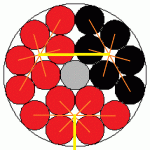fourbanger
100 W
Hi guys. First off, I just received the afore mentioned meanwell led driver from digikey for $130 Canadian pesos (super fast delivery time, btw; highly recommend) but the thing seems to max out at 58.7VDC. My question is will the 0.1V deficit give me problems balancing a 14S system using a cheapo BMS, or will it be close enough to activate the balancing function.
My other questions are regarding the battery design its self. I am attempting a cylindrical design using a 4" sewer pipe and would like to incorporate cell level fusing. I've attached a high quality MS Paint artist's rendition of what I've come up with. The yellow lines represent 12awg stranded wire, the orange lines represent individual strands serving as parallel connections. Each individual strand measures approx. 0.47mm [EDIT: 0.44mm] which I'm hoping will allow for a blow out at around 20A or so. Each set of 3S6P groups will be separated by 1/4" soft white packing foam. I'm not looking to draw more than 30A from this pack. Will this suffice, or will those little strands get too hot?
Also, I'm curious as to why people are inclined to beef up their series connections at the + and - output terminals of their battery packs? Shouldn't a current draw of 30A simply be 30A across the board for example?
Looking forward to hearing any advice, reference material or anything else that might help to un-stupify myself.
Many gracious thanks in advance.
My other questions are regarding the battery design its self. I am attempting a cylindrical design using a 4" sewer pipe and would like to incorporate cell level fusing. I've attached a high quality MS Paint artist's rendition of what I've come up with. The yellow lines represent 12awg stranded wire, the orange lines represent individual strands serving as parallel connections. Each individual strand measures approx. 0.47mm [EDIT: 0.44mm] which I'm hoping will allow for a blow out at around 20A or so. Each set of 3S6P groups will be separated by 1/4" soft white packing foam. I'm not looking to draw more than 30A from this pack. Will this suffice, or will those little strands get too hot?
Also, I'm curious as to why people are inclined to beef up their series connections at the + and - output terminals of their battery packs? Shouldn't a current draw of 30A simply be 30A across the board for example?
Looking forward to hearing any advice, reference material or anything else that might help to un-stupify myself.
Many gracious thanks in advance.


